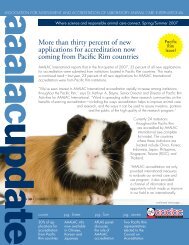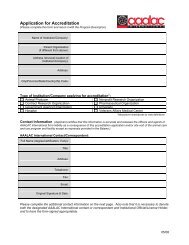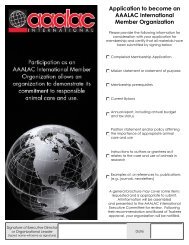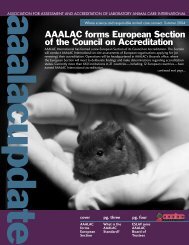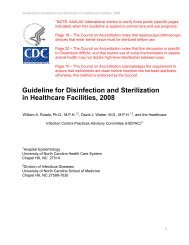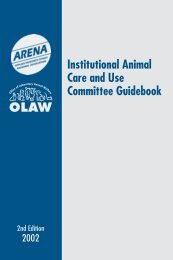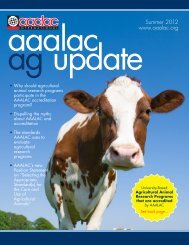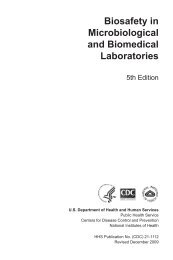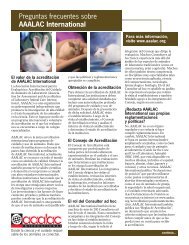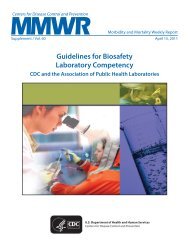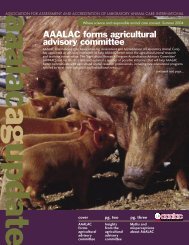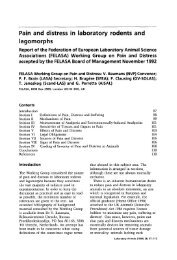18 CHAPTER 3Most agricultural animals are quite adaptable to <strong>the</strong>wide range <strong>of</strong> <strong>the</strong>rmal environments that are typicallyfound <strong>in</strong> <strong>the</strong> natural outdoor surround<strong>in</strong>gs <strong>of</strong> variousclimatic regions <strong>of</strong> <strong>the</strong> cont<strong>in</strong>ental United States. Therange <strong>of</strong> environmental temperatures over which animalsuse <strong>the</strong> m<strong>in</strong>imum amount <strong>of</strong> metabolizable dietaryenergy to control body temperature is termed <strong>the</strong><strong>the</strong>rmoneutral zone (NRC, 1981; Curtis, 1983; Yousef,1985a). Homeo<strong>the</strong>rmic metabolic responses are notneeded with<strong>in</strong> this zone. Temperature <strong>and</strong> vapor pressureranges vary widely among geographic locations.The long-term well-be<strong>in</strong>g <strong>of</strong> an animal is not necessarilycompromised each time it experiences cold or heatstress. However, <strong>the</strong> overall efficiency <strong>of</strong> metabolizableenergy use <strong>for</strong> productive purposes is generally loweroutside <strong>the</strong> <strong>the</strong>rmoneutral zone than it is with<strong>in</strong> <strong>the</strong>zone.The preferred <strong>the</strong>rmal conditions <strong>for</strong> agricultural animalslie with<strong>in</strong> <strong>the</strong> range <strong>of</strong> nom<strong>in</strong>al per<strong>for</strong>mance losses(Hahn, 1985). Actual effective environmental temperaturemay be temporarily cooler or warmer than <strong>the</strong>preferred temperature without compromis<strong>in</strong>g ei<strong>the</strong>r <strong>the</strong>overall well-be<strong>in</strong>g or <strong>the</strong> productive efficiency <strong>of</strong> <strong>the</strong> animals(NRC, 1981). Evaluation <strong>of</strong> <strong>the</strong>rmoregulation or<strong>of</strong> heat production, dissipation, <strong>and</strong> storage can serveas an <strong>in</strong>dicator <strong>of</strong> well-be<strong>in</strong>g <strong>in</strong> relation to <strong>the</strong>rmal environments(Hahn et al., 1992; Eigenberg et al., 1995;Mitloehner <strong>and</strong> Laube, 2003).The <strong>the</strong>rmal environment that animals actually experience(i.e., effective environmental temperature)represents <strong>the</strong> comb<strong>in</strong>ed effects <strong>of</strong> several variables,<strong>in</strong>clud<strong>in</strong>g air temperature, vapor pressure, air speed,surround<strong>in</strong>g surface temperatures, <strong>in</strong>sulative effects <strong>of</strong><strong>the</strong> surround<strong>in</strong>gs, <strong>and</strong> <strong>the</strong> age, sex, weight, <strong>in</strong>fectiousstatus, transgenic modification status, adaptation status,activity level, posture, stage <strong>of</strong> production, bodycondition, <strong>and</strong> dietary regimen <strong>of</strong> <strong>the</strong> animal.To overcome shortcom<strong>in</strong>gs <strong>of</strong> us<strong>in</strong>g ambient temperatureas <strong>the</strong> only <strong>in</strong>dicator <strong>of</strong> animal com<strong>for</strong>t, <strong>the</strong>rmal<strong>in</strong>dices have been developed to better characterize <strong>the</strong><strong>in</strong>fluence <strong>of</strong> multiple environmental variables on <strong>the</strong>animal. The temperature-humidity <strong>in</strong>dex (THI), firstproposed by Thom (1959), has been extensively applied<strong>for</strong> moderate to hot conditions, even with recognizedlimitations related to airspeed <strong>and</strong> radiation heatloads (NOAA, 1976). At <strong>the</strong> present time, <strong>the</strong> THI hasbecome <strong>the</strong> de facto st<strong>and</strong>ard <strong>for</strong> classify<strong>in</strong>g <strong>the</strong>rmalenvironments <strong>in</strong> many animal studies <strong>and</strong> selection <strong>of</strong>management practices dur<strong>in</strong>g seasons o<strong>the</strong>r than w<strong>in</strong>ter(Hahn et al., 2003).The THI has fur<strong>the</strong>r been used as <strong>the</strong> basis <strong>for</strong> <strong>the</strong>Livestock Wea<strong>the</strong>r Safety Index (LWSI; LCI, 1970) todescribe categories <strong>of</strong> heat stress associated with hotwea<strong>the</strong>rconditions <strong>for</strong> livestock exposed to extremeconditions. Categories <strong>in</strong> <strong>the</strong> LWSI are alert (74 < THI< 79), danger (79 ≤ THI < 84), <strong>and</strong> emergency (THI ≥84). Additionally, THI between 70 <strong>and</strong> 74 is an <strong>in</strong>dicationto producers that <strong>the</strong>y need to be aware that <strong>the</strong>potential <strong>for</strong> heat stress <strong>in</strong> livestock exists.The <strong>in</strong>dex {w<strong>in</strong>d chill temperature <strong>in</strong>dex (°C) = 13.12+ (0.6215 × AT) − [11.37 × (WSPD)0.16] + [0.3965 ×AT × (WSPD)0.16]}, where AT = air temperature, °C,<strong>and</strong> WSPD = w<strong>in</strong>d speed, m/s, is a physiological basedmodel <strong>and</strong> accounts <strong>for</strong> <strong>in</strong>herent errors <strong>in</strong> <strong>the</strong> earlierw<strong>in</strong>d chill <strong>in</strong>dex (WCI), which was not based on heattransfer properties <strong>of</strong> body tissues. However, <strong>the</strong> oldWCI closely mimicked heat loss <strong>and</strong> equivalent temperatureequations reported by Ames <strong>and</strong> Insley (1975)<strong>for</strong> sheep <strong>and</strong> cattle. Equations developed by Ames <strong>and</strong>Insley (1975) accounted <strong>for</strong> heat transfer through pelts<strong>and</strong> hides sections <strong>of</strong> previously harvested animals;however, <strong>the</strong>y did not account <strong>for</strong> fat cover <strong>and</strong> o<strong>the</strong>rregulatory processes utilized <strong>in</strong> mitigat<strong>in</strong>g cold stress.In addition, body heat loss due to w<strong>in</strong>d will be proportionalto <strong>the</strong> surface area exposed <strong>and</strong> not <strong>the</strong> entiresurface area <strong>of</strong> <strong>the</strong> body. This error was also <strong>in</strong>herent<strong>in</strong> <strong>the</strong> old WCI.A ventilation system removes heat, water vapor, <strong>and</strong>air pollutants from an enclosed animal facility (i.e., a facility<strong>in</strong> which air enters <strong>and</strong> leaves only through open<strong>in</strong>gsthat are designed expressly <strong>for</strong> those purposes) at<strong>the</strong> same time that it <strong>in</strong>troduces fresh air. Adequateventilation is a major consideration <strong>in</strong> prevention <strong>of</strong>respiratory <strong>and</strong> o<strong>the</strong>r diseases. Where temperature controlis critical, cool<strong>in</strong>g or heat<strong>in</strong>g may be required tosupplement <strong>the</strong> ventilation system. For certa<strong>in</strong> researchprojects, filtration or air condition<strong>in</strong>g may be neededas well.Typically, ventilation is <strong>the</strong> primary means <strong>of</strong> ma<strong>in</strong>ta<strong>in</strong><strong>in</strong>g<strong>the</strong> desired air temperature <strong>and</strong> water vaporpressure conditions <strong>in</strong> <strong>the</strong> animal microenvironment.The amount <strong>of</strong> ventilation needed depends on <strong>the</strong> size,number, type, age, <strong>and</strong> dietary regimen <strong>of</strong> <strong>the</strong> animals,<strong>the</strong> waste management system, <strong>and</strong> atmospheric conditions.Equipment <strong>and</strong> husb<strong>and</strong>ry practices that affec<strong>the</strong>at <strong>and</strong> water vapor loads <strong>in</strong>side <strong>the</strong> animal house alsoshould be considered <strong>in</strong> <strong>the</strong> design <strong>and</strong> operation <strong>of</strong> <strong>the</strong>ventilation system.Ventilation rates <strong>in</strong> enclosed facilities (MWPS, 1989,1990a,b) should <strong>in</strong>crease from a cold-season m<strong>in</strong>imum(to remove water vapor, contam<strong>in</strong>ants, <strong>and</strong> odors aswell as modify <strong>in</strong>side temperature) to a hot-seasonmaximum (usually around 10 times <strong>the</strong> m<strong>in</strong>imum rate,to limit <strong>the</strong> <strong>in</strong>crease <strong>in</strong> temperature <strong>in</strong>side <strong>the</strong> housethat is due to <strong>the</strong> solar radiation load <strong>and</strong> sensibleanimal heat). It is important to recognize <strong>the</strong> approximately10-fold <strong>in</strong>crease <strong>in</strong> ventilation rate from w<strong>in</strong>terto summer that is required <strong>in</strong> a typical livestockor poultry house. Because <strong>the</strong> animals <strong>the</strong>mselves are<strong>the</strong> major source <strong>of</strong> water vapor, heat, <strong>and</strong> (<strong>in</strong>directly)odorous matter, ventilation rate calculated on <strong>the</strong> basis<strong>of</strong> animal mass is more accurate than that based on airexchangerate guidel<strong>in</strong>es.Relative humidity is ord<strong>in</strong>arily <strong>the</strong> parameter usedto manage <strong>the</strong> air moisture content. Hot wea<strong>the</strong>r ventilationrates should be sufficiently high to ma<strong>in</strong>ta<strong>in</strong><strong>the</strong> relative humidity below 80% <strong>in</strong> an enclosed animalhouse (Curtis, 1983; H<strong>in</strong>kle <strong>and</strong> Strombaugh, 1983) ex-
cept <strong>for</strong> situations <strong>in</strong> which high relative humidity doesnot cause animal health concerns. Conversely, ventilationrate dur<strong>in</strong>g cold wea<strong>the</strong>r should be sufficiently lowto ensure that <strong>the</strong> relative humidity does not fall to alevel that causes animal health concerns, unless needs<strong>for</strong> air quality or condensation control necessitate ahigher rate. Atmospheric humidity does not ord<strong>in</strong>arilybecome a significant factor <strong>in</strong> effective environmentaltemperature until <strong>the</strong> air temperature approaches <strong>the</strong>temperature <strong>of</strong> <strong>the</strong> animal’s surface, <strong>in</strong> which case <strong>the</strong>animal will depend almost entirely on evaporative heatloss to ma<strong>in</strong>ta<strong>in</strong> <strong>the</strong>rmal equilibrium with <strong>the</strong> environment.The use <strong>of</strong> fans to promote air movement can be beneficialdur<strong>in</strong>g hot wea<strong>the</strong>r if <strong>the</strong>re is too little naturalair movement. Direct wett<strong>in</strong>g is effective <strong>in</strong> decreas<strong>in</strong>gheat stress on cattle <strong>and</strong> pigs; however, it can cause <strong>the</strong>death <strong>of</strong> poultry. Wett<strong>in</strong>g is best accomplished by waterspr<strong>in</strong>kled or dripped directly on <strong>the</strong> animals. Misters<strong>and</strong> evaporative coolers specifically designed to reduceair dry-bulb temperature are also used to reduce heatstress on agricultural animals.Correctly designed <strong>and</strong> ma<strong>in</strong>ta<strong>in</strong>ed sunshades protectanimals from heat stress by reduc<strong>in</strong>g solar radiationload. Trees, if available, are ideal sunshades. Artificial,ro<strong>of</strong>ed shades are acceptable.Mechanical ventilation requires proper design <strong>and</strong>operation <strong>of</strong> both air <strong>in</strong>lets <strong>and</strong> fans <strong>for</strong> proper distribution<strong>and</strong> mix<strong>in</strong>g <strong>of</strong> <strong>the</strong> air <strong>and</strong> thus <strong>for</strong> creat<strong>in</strong>guni<strong>for</strong>m conditions throughout <strong>the</strong> animal liv<strong>in</strong>g space.Mechanical ventilation, with fans creat<strong>in</strong>g static pressuredifferences between <strong>in</strong>side <strong>and</strong> outside <strong>the</strong> house,br<strong>in</strong>gs <strong>in</strong> fresh air <strong>and</strong> exhausts air that has pickedup heat, water vapor, <strong>and</strong> air pollutants while pass<strong>in</strong>gthrough <strong>the</strong> build<strong>in</strong>g. Mechanical ventilation, if properlydesigned, provides better control <strong>of</strong> air exchange<strong>for</strong> enclosed, <strong>in</strong>sulated animal houses <strong>in</strong> colder climatesthan does natural ventilation. The effectiveness <strong>of</strong> naturalventilation <strong>in</strong> cold climates will depend on <strong>the</strong> design<strong>and</strong> orientation <strong>of</strong> <strong>the</strong> enclosure, as well as <strong>the</strong>species <strong>and</strong> number <strong>of</strong> animals housed <strong>and</strong> <strong>the</strong> stage <strong>of</strong><strong>the</strong>ir life cycle.Natural ventilation uses <strong>the</strong>rmal buoyancy <strong>and</strong> w<strong>in</strong>dcurrents to vent air through open<strong>in</strong>gs <strong>in</strong> outside wallsor at <strong>the</strong> ridge <strong>of</strong> <strong>the</strong> build<strong>in</strong>g. Natural ventilation isespecially effective <strong>for</strong> cold animal houses (i.e., houses<strong>in</strong> which no heat is supplied <strong>in</strong> addition to animal heat)<strong>in</strong> moderate climates; however, <strong>in</strong>sulated walls, ceil<strong>in</strong>gs,<strong>and</strong> floors are <strong>of</strong>ten recommended to m<strong>in</strong>imize condensation.The air exchange rate needed to remove <strong>the</strong>water vapor generated by animals <strong>and</strong> evaporation <strong>of</strong>water from environmental surfaces <strong>of</strong>ten br<strong>in</strong>gs air temperature<strong>in</strong>side such houses down to values near thoseoutdoors. If waterers <strong>and</strong> water pipes are protectedfrom freez<strong>in</strong>g, <strong>the</strong> practical low operat<strong>in</strong>g temperatureis <strong>the</strong> po<strong>in</strong>t at which manure freezes, although this temperaturewould be too cold <strong>for</strong> some species or stages<strong>of</strong> <strong>the</strong> life cycle. Automatic curta<strong>in</strong>s or vent panels,HUSBANDRY, HOUSING, AND BIOSECURITY<strong>in</strong>sulated ceil<strong>in</strong>gs, <strong>and</strong> circulat<strong>in</strong>g fans help to regulate<strong>and</strong> enhance natural ventilation systems.Dur<strong>in</strong>g cold wea<strong>the</strong>r, ventilation <strong>in</strong> houses <strong>for</strong> neonatalanimals should ma<strong>in</strong>ta<strong>in</strong> acceptable air quality<strong>in</strong> terms <strong>of</strong> water vapor <strong>and</strong> o<strong>the</strong>r pollutants withoutchill<strong>in</strong>g <strong>the</strong> animals. Air speed should be less than 0.25m/s (50 ft/m<strong>in</strong>) past very young animals. There shouldbe no drafts on young poultry or pigs.Dur<strong>in</strong>g hot, warm, or cool atmospheric conditions,ventilation <strong>of</strong> animal houses should ma<strong>in</strong>ta<strong>in</strong> <strong>the</strong> <strong>the</strong>rmalcom<strong>for</strong>t <strong>of</strong> <strong>the</strong> animal to <strong>the</strong> extent possible. Ideally,<strong>the</strong> ventilation rate should be high enough to prevent<strong>in</strong>door temperature from exceed<strong>in</strong>g outdoor temperature(temperature rise limit; Curtis, 1983) by morethan 3°C (5°F) when <strong>the</strong> atmospheric temperature isabove 32°C (90°F) <strong>for</strong> small animals <strong>and</strong> above 25°C(78°F) <strong>for</strong> larger ones. In arid <strong>and</strong> semi-arid regionswhere <strong>the</strong> potential <strong>for</strong> evaporative heat loss is great,air temperature may peak at over 43°C (110°F) <strong>for</strong> 1or 2 d or longer without affect<strong>in</strong>g animal well-be<strong>in</strong>g ifanimals have been acclimatized by chronic exposure.Ventilation system design should be based on build<strong>in</strong>gconstruction <strong>and</strong> <strong>the</strong> rates <strong>of</strong> water vapor <strong>and</strong> heatproduction <strong>of</strong> <strong>the</strong> animals housed (Curtis, 1983; H<strong>in</strong>kle<strong>and</strong> Strombaugh, 1983). The frame <strong>of</strong> reference is <strong>the</strong>animal microenvironment. For example, <strong>the</strong> outdoorcalf hutch is a popular accommodation <strong>for</strong> dairy replacemen<strong>the</strong>ifer calves <strong>in</strong> most parts <strong>of</strong> <strong>the</strong> cont<strong>in</strong>entalUnited States. Although <strong>the</strong> hutch provides a coldmicroenvironment <strong>for</strong> calves dur<strong>in</strong>g w<strong>in</strong>ter <strong>in</strong> nor<strong>the</strong>rnlatitudes, <strong>the</strong> calf is none<strong>the</strong>less com<strong>for</strong>table if cared<strong>for</strong> correctly (MWPS, 1995). In closed houses dur<strong>in</strong>ghot periods, additional ventilation capacity (up to 60 ormore air changes/hour) may be necessary.In enclosed animal houses, both environmental temperature<strong>and</strong> air quality depend on <strong>the</strong> cont<strong>in</strong>uousfunction<strong>in</strong>g <strong>of</strong> <strong>the</strong> ventilation system. An automaticwarn<strong>in</strong>g system is desirable to alert animal care <strong>and</strong> securitypersonnel to power failures <strong>and</strong> out-<strong>of</strong>-toleranceenvironmental conditions (Clark <strong>and</strong> Hahn, 1971), <strong>and</strong>consideration should be given to hav<strong>in</strong>g an on-site generator<strong>for</strong> emergency use.The relative air pressures between animal areas <strong>and</strong>service areas <strong>of</strong> a build<strong>in</strong>g hous<strong>in</strong>g animals should beconsidered when <strong>the</strong> ventilation system is designed tom<strong>in</strong>imize <strong>the</strong> <strong>in</strong>troduction <strong>of</strong> airborne disease agents orair pollutants <strong>in</strong>to <strong>the</strong> service area. Advice <strong>of</strong> a qualifiedagricultural eng<strong>in</strong>eer or o<strong>the</strong>r specialist should besought <strong>for</strong> <strong>the</strong> design <strong>of</strong> <strong>and</strong> operat<strong>in</strong>g recommendations<strong>for</strong> ventilation equipment.Air QualityAir quality refers to <strong>the</strong> nature <strong>of</strong> <strong>the</strong> air with respectto its effects on <strong>the</strong> health <strong>and</strong> well-be<strong>in</strong>g <strong>of</strong> animals<strong>and</strong> <strong>the</strong> humans who work with <strong>the</strong>m. Air quality istypically def<strong>in</strong>ed <strong>in</strong> terms <strong>of</strong> <strong>the</strong> air content <strong>of</strong> certa<strong>in</strong>19
- Page 1 and 2: Guide for the Care and Useof Agricu
- Page 3 and 4: Guide Revision Committees for the F
- Page 5 and 6: Chapter 6: Beef Cattle 61Facilities
- Page 7: PrefaceThis is the third edition of
- Page 10 and 11: 2 CHAPTER 1The IACUC should meet at
- Page 12 and 13: 4 CHAPTER 1tion Center at the Natio
- Page 14 and 15: 6 CHAPTER 1Disposition of Animal Cl
- Page 16 and 17: Chapter 2: Agricultural Animal Heal
- Page 18 and 19: 10 CHAPTER 2and behavioral health e
- Page 20 and 21: 12 CHAPTER 2care attendants or rese
- Page 22 and 23: 14 CHAPTER 2exposed to these chemic
- Page 24 and 25: Chapter 3: Husbandry, Housing, and
- Page 28 and 29: 20 CHAPTER 3gases, particulates, an
- Page 30 and 31: 22 CHAPTER 3in pairs or groups when
- Page 32 and 33: 24 CHAPTER 3screened with 1.3-cm (0
- Page 34 and 35: 26 CHAPTER 3priate, and institution
- Page 36 and 37: 28 CHAPTER 3ings and Deliberations.
- Page 38 and 39: Chapter 4: Environmental Enrichment
- Page 40 and 41: 32 CHAPTER 4(Feh and de Mazieres, 1
- Page 42 and 43: 34 CHAPTER 4Substrate: The provisio
- Page 44 and 45: 36 CHAPTER 4mize regrouping and soc
- Page 46 and 47: 38 CHAPTER 4not especially attracte
- Page 48 and 49: 40 CHAPTER 4Croney, C. C., K. M. Ad
- Page 50 and 51: 42 CHAPTER 4Meunier-Salaün, M. C.,
- Page 52 and 53: 44 CHAPTER 4Wilson, S. C., F. M. Mi
- Page 54 and 55: 46 CHAPTER 5dling facility in the f
- Page 56 and 57: 48 CHAPTER 5Table 5-1. Visual distr
- Page 58 and 59: 50 CHAPTER 5Animals should be handl
- Page 60 and 61: 52 CHAPTER 5be given during conditi
- Page 62 and 63: 54 CHAPTER 5mercial broiler farms,
- Page 64 and 65: 56 CHAPTER 5The condition of the an
- Page 66 and 67: 58 CHAPTER 5Arnold, G. W. 1977. An
- Page 68 and 69: 60 CHAPTER 5for veterinary and husb
- Page 70 and 71: 62 CHAPTER 6managers of confined ca
- Page 72 and 73: 64 CHAPTER 6Cold housing can be pro
- Page 74 and 75: 66 CHAPTER 6HUSBANDRYAdequate care
- Page 76 and 77:
68 CHAPTER 6ately to perform a caes
- Page 78 and 79:
70 CHAPTER 6minimum amount of time
- Page 80 and 81:
72 CHAPTER 6Ensminger, M. E. 1970.
- Page 82 and 83:
Chapter 7: Dairy CattleDairy cattle
- Page 84 and 85:
76 CHAPTER 7Table 7-1. Recommended
- Page 86 and 87:
78 CHAPTER 7ties should be provided
- Page 88 and 89:
80 CHAPTER 7quent feeding, and exce
- Page 90 and 91:
82 CHAPTER 7hanced sensitivity to h
- Page 92 and 93:
84 CHAPTER 7effective for removing
- Page 94 and 95:
86 CHAPTER 7Albright, J. L. 1978. S
- Page 96 and 97:
88 CHAPTER 7Murphy, M. R., C. L. Da
- Page 98 and 99:
Chapter 8: HorsesMost horses are us
- Page 100 and 101:
92 CHAPTER 8Temperature and Ventila
- Page 102 and 103:
94 CHAPTER 8tritional programs for
- Page 104 and 105:
96 CHAPTER 8WaterClean water should
- Page 106 and 107:
98 CHAPTER 8bots (Gastrophilus inte
- Page 108 and 109:
100 CHAPTER 8STANDARD AGRICULTURALP
- Page 110 and 111:
102 CHAPTER 8of Animals. C. McGowan
- Page 112 and 113:
104 CHAPTER 9dom of movement, runni
- Page 114 and 115:
106 CHAPTER 92006). Developing bree
- Page 116 and 117:
108 CHAPTER 9Table 9-3. Minimum fee
- Page 118 and 119:
110 CHAPTER 9Table 9-7. Minimum dri
- Page 120 and 121:
112 CHAPTER 9Table 9-10. Minimum fl
- Page 122 and 123:
114 CHAPTER 9Table 9-12. Minimum fl
- Page 124 and 125:
116 CHAPTER 9ery effort should be m
- Page 126 and 127:
118 CHAPTER 9guides, available from
- Page 128 and 129:
120 CHAPTER 9nutritive pecking decr
- Page 130 and 131:
122 CHAPTER 9rapidly fragmented by
- Page 132 and 133:
124 CHAPTER 9Brambell, F. W. R. 196
- Page 134 and 135:
126 CHAPTER 9Hughes, B. O., and M.
- Page 136 and 137:
128 CHAPTER 9chickens grown with tw
- Page 138 and 139:
130 CHAPTER 10Table 10-1. Recommend
- Page 140 and 141:
132 CHAPTER 10prevented or minimize
- Page 142 and 143:
134 CHAPTER 10and well-being (Matte
- Page 144 and 145:
136 CHAPTER 10via colostrum (de la
- Page 146 and 147:
138 CHAPTER 10thoroughly at the beg
- Page 148 and 149:
140 CHAPTER 10Ames, D. R., J. E. Ne
- Page 150 and 151:
142 CHAPTER 102006. Semen and repro
- Page 152 and 153:
144 CHAPTER 11Table 11-1. Recommend
- Page 154 and 155:
146 CHAPTER 11vided in the creep ar
- Page 156 and 157:
148 CHAPTER 11Table 11-2. Minimum f
- Page 158 and 159:
150 CHAPTER 11are kept in small gro
- Page 160 and 161:
152 CHAPTER 11sonable to consolidat
- Page 162 and 163:
154 CHAPTER 11Blackshaw, J. K., F.
- Page 164 and 165:
156 CHAPTER 11populations structure
- Page 166 and 167:
Appendix 2Table A-1. Zoonotic disea
- Page 168 and 169:
IndexAAABP (American Association of
- Page 170 and 171:
162 INDEXcold climates. See also te
- Page 172 and 173:
164 INDEXdairy, 137disbudding of, 1
- Page 174 and 175:
166 INDEXmisters, 19mites, 98Model
- Page 176 and 177:
168 INDEXin horse stalls, 90in poul



